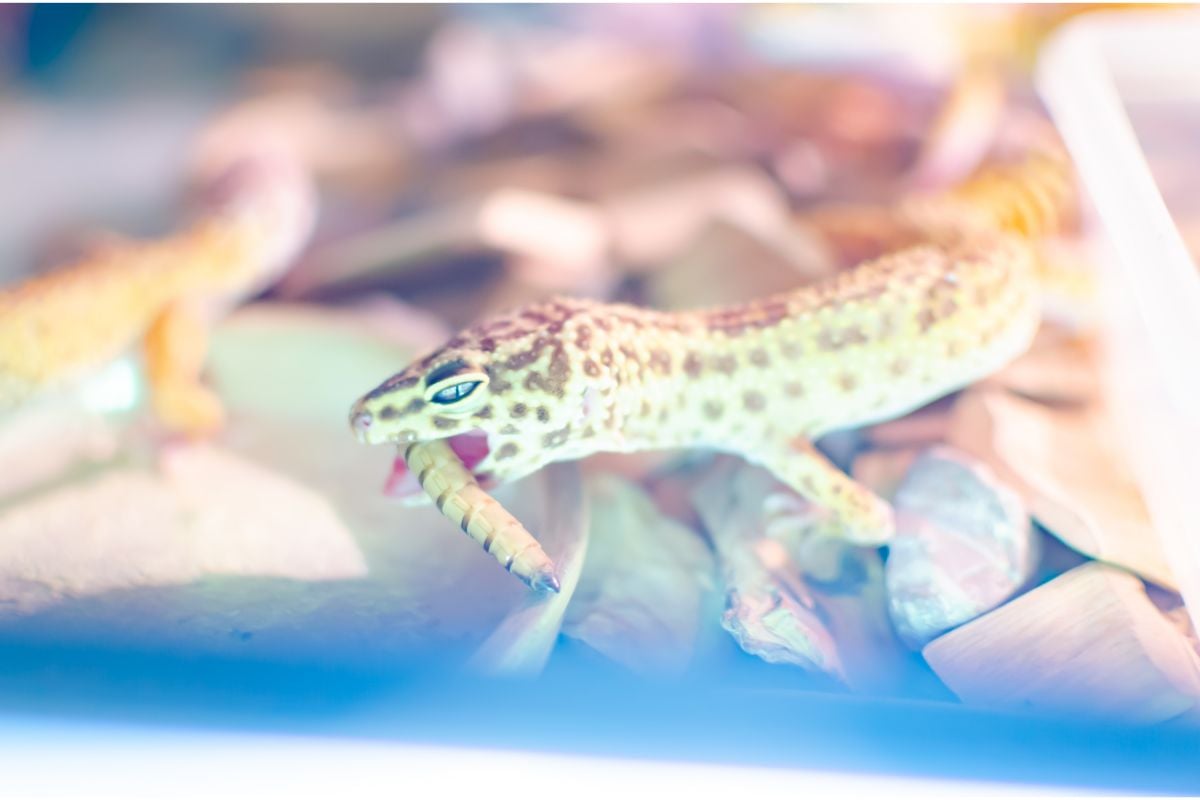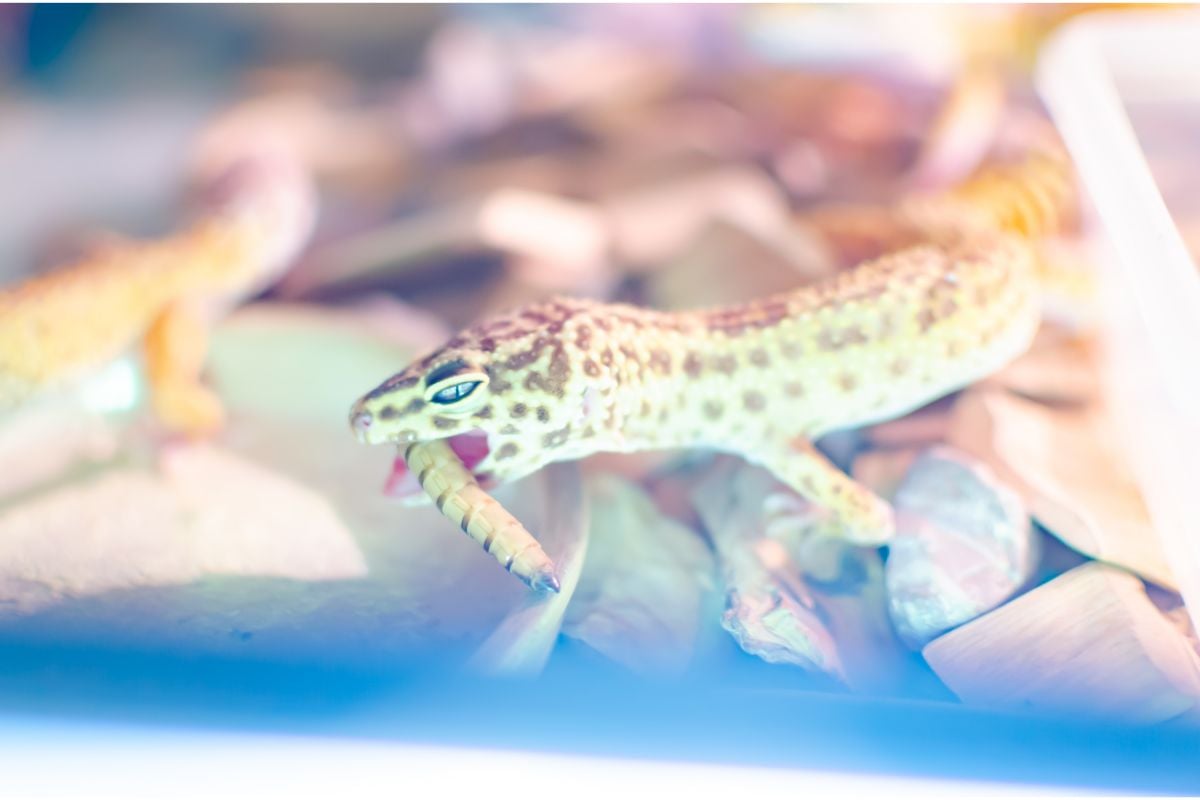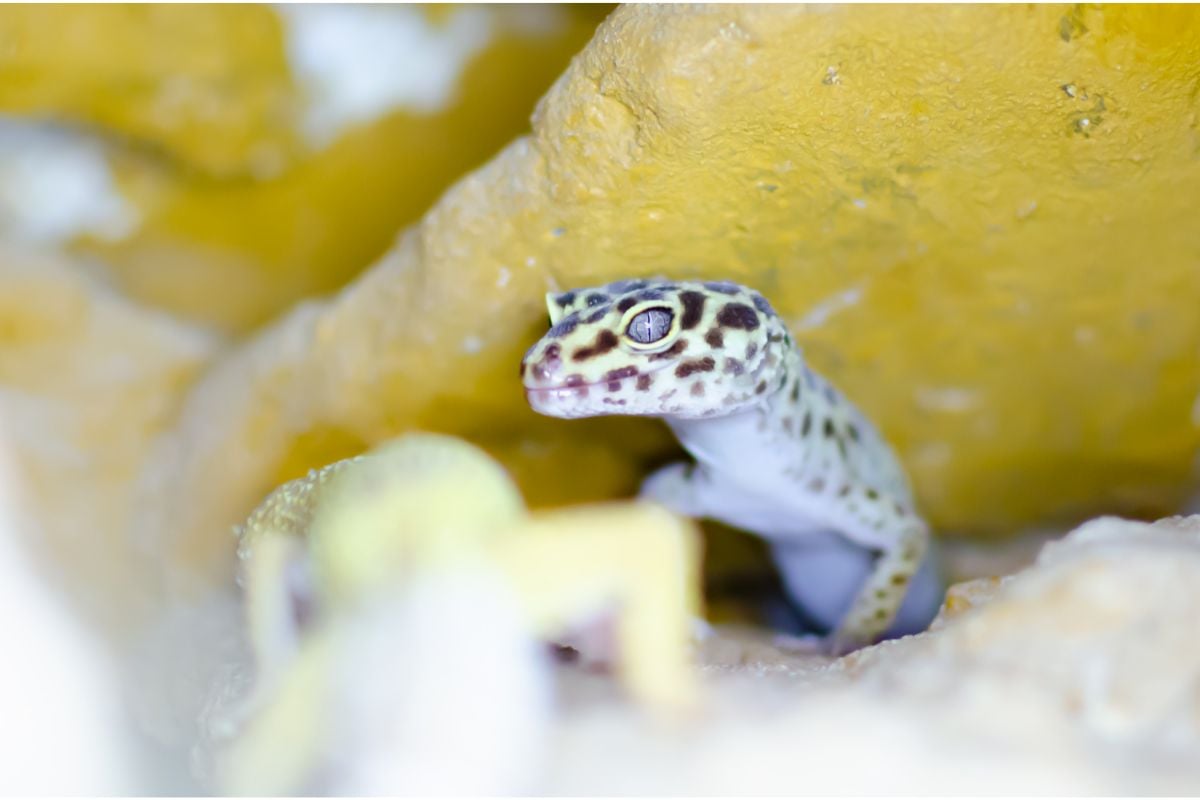Leopard Geckos are an extremely popular kind of reptile that people keep as pets.
They are so popular because they are considered to be a lot easier to look after than lots of other types of reptiles and they are incredibly quirky and unique in terms of pets.

If you are new to Leopard Geckos though, you might need a bit of extra help and advice in order to care for them properly, and we are here to help you!
Lots of pets, like dogs and cats, can share human food with their owners, so you might be wondering if the same applies to Leopard Geckos.
Well if you are, you have come to the right place! We are going to go over everything you need to know about Leopard Geckos, especially the kinds of human foods they can (or cannot) eat.
If you want to know more about what Leopard Geckos can eat, read on to find out all the information you should know.
What Are Leopard Geckos?
Leopard Geckos are a type of small, ground-dwelling lizard that is native to areas such as Afghanistan, Iran, Pakistan, India, and Nepal.
They are known for their fat tails which function as fat reserve storage and they are also known for their ability of self-amputating their tail!
Leopard Geckos are generally not very social creatures, both in terms of humans and other geckos, and they will happily spend their time in one spot rather than venturing out to discover more about their surroundings.
Because they are such a small kind of reptile, they do not have many defense mechanisms in place in regard to predators, but they do use their tails to escape dangerous situations.
They are also a nocturnal kind of reptile, so if you keep one in captivity, you can expect little to no action in the day and lots of action at night.
They are a fascinating kind of gecko and keeping them as a pet will definitely be an incredible experience for you.
Can Leopard Geckos Eat Human Food?
So if you want to feed your Leopard Gecko some human food, there are a couple of important things you need to know before you do it.
You would be surprised by how many people have already asked this question, and they even have specific foods that they have asked about.
Some of the most popular foods people want to share with their Leopard Geckos include rice, pasta, fruit and vegetables, eggs, and even salads.
But what all of these people did not know when they first asked the question is that Leopard Geckos actually can not eat human food.
The reason they cannot eat human food is due to the fact that they have no cecum in their body.
Cecum is a part of the body that has the ability to break down cellulose, which works for foods such as fruits and vegetables.
Leopard Geckos are biologically designed to break down and digest insects and nothing that resembles human food.
Another reason why Leopard Geckos cannot eat human food is that they have a shorter digestive tract and their tract is actually alkaline based.
Other creatures, such as humans and herbivores have a much longer and more acidic digestive tract, which is why they are able to break down human food.
Also, the Leopard Gecko’s inability to digest human food also comes from the shape of its skull. These creatures have very small skulls which have evolved over time to be able to process and digest meat.
Their skulls are not shaped in the same way as a herbivore’s skull, which also contributes to why they can’t digest human food.
So if you were considering feeding your Leopard Gecko some human food, we have to tell you that this is an extremely bad idea.
Human food can be seriously dangerous to your Leopard Gecko and they will not be able to digest it.
It’s in your best interest (and your Leopard Geckos) to avoid giving them human food altogether and stick to their regular and advised diet.
Can Leopard Geckos Eat Fish?
If Leopard Geckos can only eat meat, then surely they can eat fish, right?
Well, actually, fish is not a suitable food to feed your Leopard Gecko. Sure, it is technically meet, and it is completely natural, but not for Leopard Geckos.
These small reptiles come from the desert, and they are used to eating foods that you would find in the desert, even if they are kept in captivity. In the desert, there is definitely no fish!
Another thing you have to bare in mind about fish is that most of them have very small and sharp bones throughout their body, and if these bones get swallowed by your Leopard Gecko, this can seriously hurt them.
Leopard Geckos are incredibly small, and even small fish bones can be hazardous to them.
If you were to feed them raw fish instead of cooked fish, this would also be a problem.
Raw fish has a high chance of infecting your Leopard Gecko with parasites, which in turn could seriously harm them.
It’s better to avoid feeding them raw fish because once they get a parasite, it can be quite difficult to get rid of them.
Overall, it is just better to avoid feeding your Leopard Gecko fish, and in regards to their safety and health, you can just consider fish to be “human food” in this instance.
It is always better to be safe rather than sorry when it comes to your Leopard Gecko and no kind of fish is going to be suitable to feed them.

What Can You Feed A Leopard Gecko?
So we have gone over what you shouldn’t feed your Leopard Gecko, but now, let’s go over what you can feed to them.
Insects are all that Leopard Geckos are really designed to eat, so the best kinds of insects you can feed them include mealworms, crickets, Dubia roaches, and hoppers.
In some cases, worms are also a great option for your Leopard Gecko and the best kinds that you can feed them include Waxworms, butterworms, and hornworms.
However, worms should not be treated the same way as food as you would use mealworms, crickets, Dubia roaches, and hoppers.
For example, waxworms and butterworms should only be given to your Leopard Geckos once in a blue moon as a treat, and this is because they have an extremely high-fat content.
If you were to feed them waxworms and butterworms all the time, it would cause your Leopard Geckos to gain weight and eventually become obese.
Another thing you should be aware of is that Leopard Geckos can actually become addicted to butterworms if they are fed them too often.
When they become addicted to butterworms, they can even end up refusing to eat any of their regular foods and this can cause serious health problems for the gecko.
It would be like a human only ever eating really unhealthy burgers and not getting any nutrients or things their body needs.
You must also make sure that when you do feed your Leopard Gecko, only feed them live foods.
Most Leopard Geckos won’t touch their required foods if they are already dead, so it’s better to just avoid the risk of them not eating and just give them the live food instead.
If you are a bit squeamish with live insects, then it is important to know that this will be the main staple in a Leopard Geckos diet, and if you haven’t purchased a Leopard Gecko yet, you may want to reconsider.
You can find lots of helpful guides and information online about how to work on your Leopard Geckos diet, so make sure you have a look around if you need to.
A Closer Look At Worms
Mealworms, crickets, Dubia roaches, and hoppers are what Leopard Geckos usually eat, but they are quite keen on worms of all different kinds.
But you need to pay more attention when you are feeding the worms to your Leopard Gecko.
Worms in general are great for Leopard Geckos because they absolutely love the taste and they are actually quite cheap to buy.
To learn a bit more about the best kinds of worms to feed your Leopard Geckos, read on!
Super Worms
Super worms are great to feed to your Leopard Gecko, especially when you want to give them a treat. It is best not to feed your Leopard Gecko super worms any more than once every two weeks.
Super worms are actually quite high in fat and they are perfect for Leopard Geckos because they are quite picky eaters! You can actually buy super worms online too!
Hornworms
Hornworms are another suitable option for Leopard Geckos. They are incredibly appealing in taste to Leopard Geckos and they are actually a great source of calcium thanks to their high calcium content.
Leopard Geckos actually enjoy Hornworms because they are nutritious, and they are great to give to them as a treat if you want to give them something a bit different.
Mealworms
Mealworms are one of the types of worms that Leopard Geckos absolutely love.
You can get them in various different sizes as well, which is perfect for Leopard Geckos because they change and grow depending on their age.
You can easily find mealworms online and your Leopard Gecko will definitely appreciate this treat when you feed it to them.
Butterworms
Butterworms are extremely high in fat and they are great to give to your Leopard Gecko as a treat to break up their usual diet and make it a bit more varied.
Butterworms are especially great if your Leopard Gecko has been sick or ill and you need to help them gain weight a bit faster.
If your Leopard Gecko is of good health though, try to minimize how often you give them butterworms and you do not need to feed them butterworms in high quantities either.
If they are already healthy and of a good weight, feeding them too many butterworms can actually cause them to become obese.
Wax Worms
Wax worms are another favorite of the Leopard Gecko and if you just left them a huge pile of them, they would eat them all.
This is why it is super important to regulate and restrict how much your Leopard Gecko can actually consume.
If they eat too many wax worms, they run the risk of becoming obese, and obesity is always a huge problem across all different species.
At most, you should only feed your Leopard Gecko wax worms every one to two weeks as a special treat.
The Importance Of Dusting
Whenever you do feed your Leopard Gecko, there is a process you need to go through in order to make it safer and healthy for your reptile.
Whenever you plan on feeding your Leopard Gecko you have to make sure that the insects you are feeding them have been gut loaded and dusted with a reptile calcium multivitamin supplement.
This is what is known as “dusting”.
This calcium multivitamin supplement will provide your Leopard Gecko with D3, which will give them the extra help to be able to maintain healthy bones, plus calcium, nutrients, and more.
Insects do not have as much nutritional value as some other species, and the calcium multivitamin supplement just gives your Leopard Gecko a better chance of maintaining good health.
In order to dust properly, all you need to do is put the insects into a sandwich bag. Once you have done this, take the calcium multivitamin supplement and add it to the bag with the insects.
Then, simply shake the whole bag to make sure that the supplement is dusting and coating the insects. Finally, once the dusting is complete, simply feed your Leopard Gecko.
In order for this action to hold any value, you will need to do a gut load every single time you feed your Leopard Gecko.
To do this, simply place the insects you plan on feeding to your Leopard Gecko into an enclosure filled with potato, oats, bran, leafy greens, or carrots.
The insects will then feed on the foods you have placed in the enclosure.
Leave the insects in there for 24 hours before you feed them to your Leopard Gecko. Your Gecko actually gets the nutrients from fruits and vegetables by consuming the insects that have recently eaten them.
When feeding your Leopard Gecko, it is also important to closely observe and monitor them. You need to watch out for when they are done feeding, in order to avoid them overeating.
If you leave certain insects in with your Leopard Geckos, such as crickets, they can start biting your Gecko, so it’s best to keep a close eye on them to avoid this and just remove them when they are done.

When To Feed Your Leopard Gecko
So now you have a better understanding of what to feed your Leopard Gecko, you are probably wondering when you should feed them.
Knowing when the best time is to feed your Leopard Gecko is super important because it helps you in staying more cost-effective, as well as keep your Leopard Gecko in a healthier state of being.
It also stops your Leopard Gecko from overfeeding and becoming obese.
If your Leopard Gecko is a baby or a juvenile, so any time under the age of one year, they need to be given food every single day.
This will aid in their growth and like most babies, they need to feed more frequently in order to grow properly.
In contrast, adult Leopard Geckos need to be fed every other day and do not need to feed as frequently as babies or juveniles.
If your Leopard Gecko is sick or under the weather in any way, you should feed them once a day.
Even if they are adults, this once-a-day rule still applies. This will help them regain their strength and get better faster.
Leopard Geckos are crepuscular animals, so when it comes to their feeding time, you do not need to directly feed them yourself.
Instead, simply drop their food into their enclosure and they will do the rest of the work.
When it comes to dropping their food into the enclosure, make sure to do it later in the day or the early evening. It’s recommended to do it at this time because Leopard Geckos are nocturnal.
For Leopard Geckos that are picky eaters, you need to feed them at appropriate times for their ages, but you can place a couple of worms into their enclosure for them to feed on when they feel ready.
As long as you follow these tips and advice, you should have no issues feeding your Leopard Gecko at the appropriate times.
It can be harder when your Leopard Gecko is more of a picky eater, but be patient and just keep an eye on them.
Issues In Overfeeding
As we have previously mentioned, when you overfeed your Leopard Gecko, this can cause a lot of problems in regard to their health.
Leopard Geckos are quite small reptiles and they don’t need huge quantities of food in order to be fulfilled. They also store a lot of fat in the fat reserves of their tails.
Obesity can be a real problem for Leopard Geckos, and it is the owner’s responsibility to make sure that they are being fed the appropriate and right amount of food.
Signs that your Leopard Gecko is obese or overweight include chubby legs and lethargic behavior, and they can also develop bubbles near or under the armpit.
If you notice any of these signs, you need to reduce how much you are feeding them and give them a chance to lose some of the weight.
Obesity is really dangerous for Leopard Geckos and it can cause them a whole heap of health problems. Not to mention, it will make them physically uncomfortable.
Another thing you need to be aware of is when your Leopard Gecko has been fed too much, there is a chance that it will regurgitate its food.
This can be unpleasant for you to clean up but it can also stress your Leopard Gecko out, and if Leopard Geckos get too stressed they can drop their tails to compensate.
While it isn’t fatal for your Leopard Gecko to lose its tail (it will grow back) it is still not ideal.
Because Leopard Geckos use their tails as fat reserve storage, it is natural for them to take the energy they have consumed through their food and store it away, and this is why they might appear underweight to you.
But more often than not, they are actually a healthy weight and you do not need to overfeed them. Overfeeding is dangerous and detrimental to your Leopard Gecko’s health.
Conclusion
When you are new to caring for a Leopard Gecko, it can be quite difficult to work out what you can and can’t feed them.
The most important takeaway here is that you never feed your Leopard Gecko human food and you never overfeed them. They simply cannot digest it and human food is not appropriate for them.
Leopard Geckos love insects, especially crickets and worms, but if you are going to feed them worms, make sure you reserve them more for treats instead of as their main meal!
- Can Leopard Geckos Eat Silkworms? - March 11, 2024
- Do Leopard Geckos Climb? - March 4, 2024
- Do Leopard Geckos Bask? The Answer Will Surprise You - February 21, 2024
